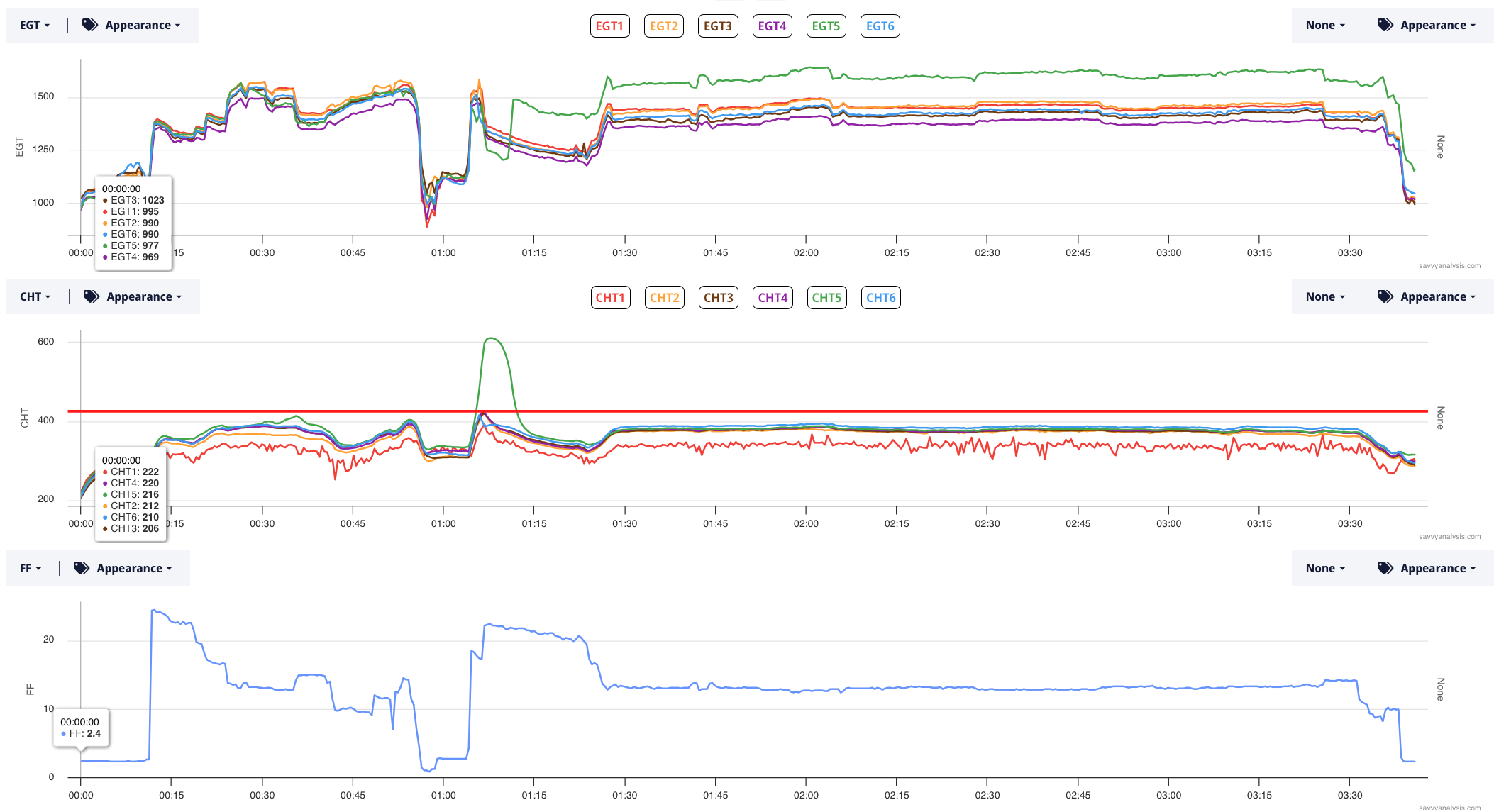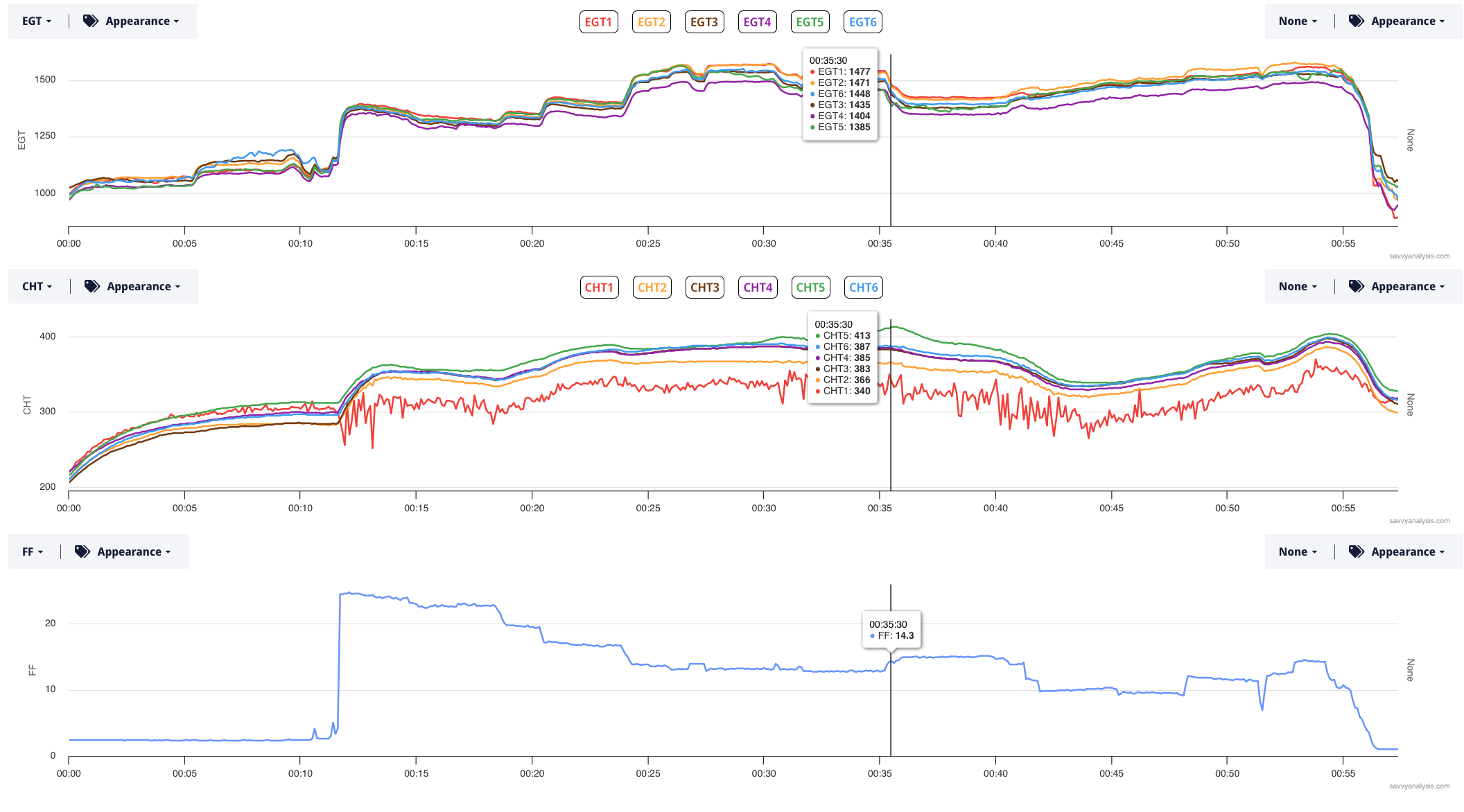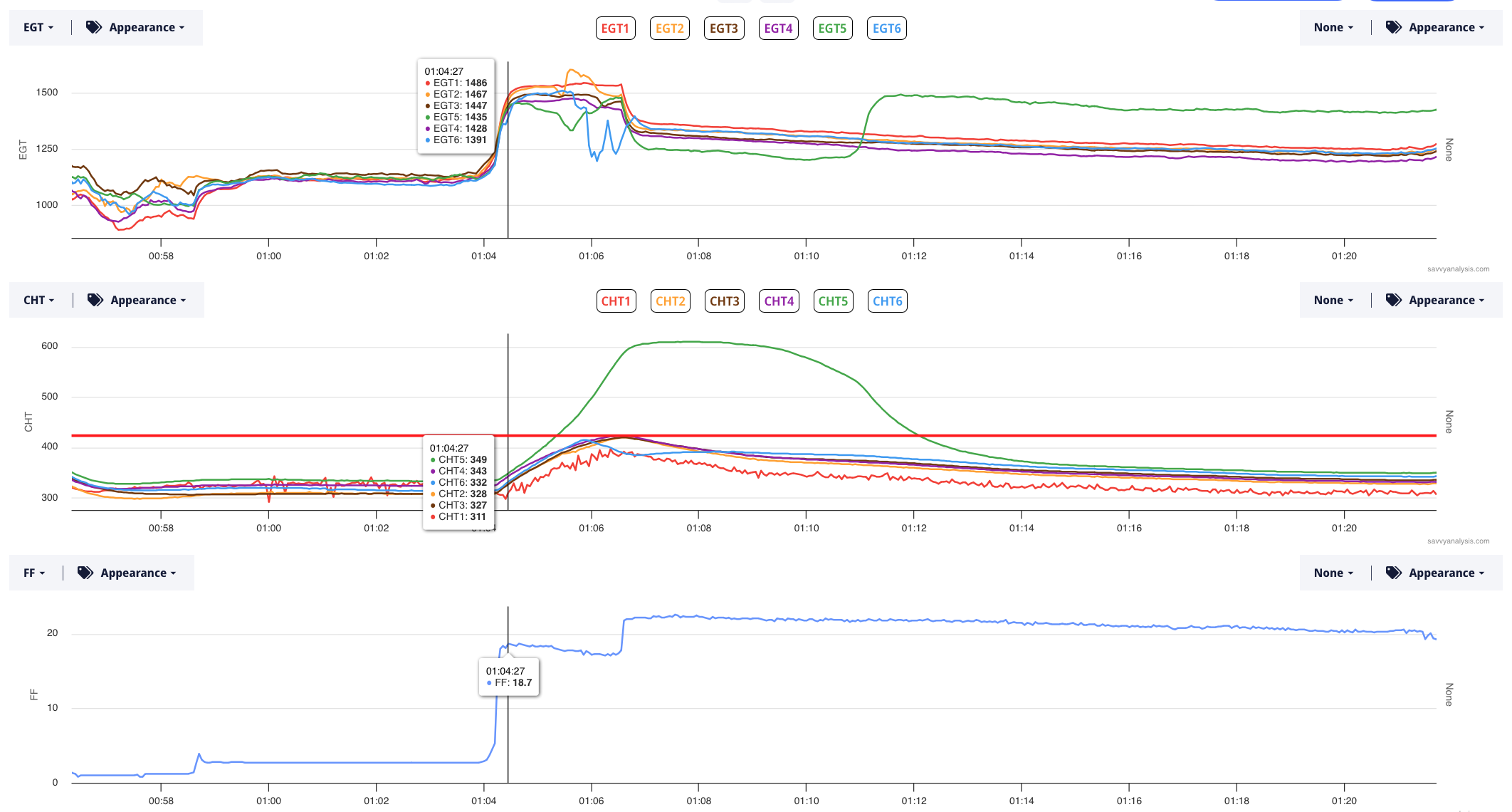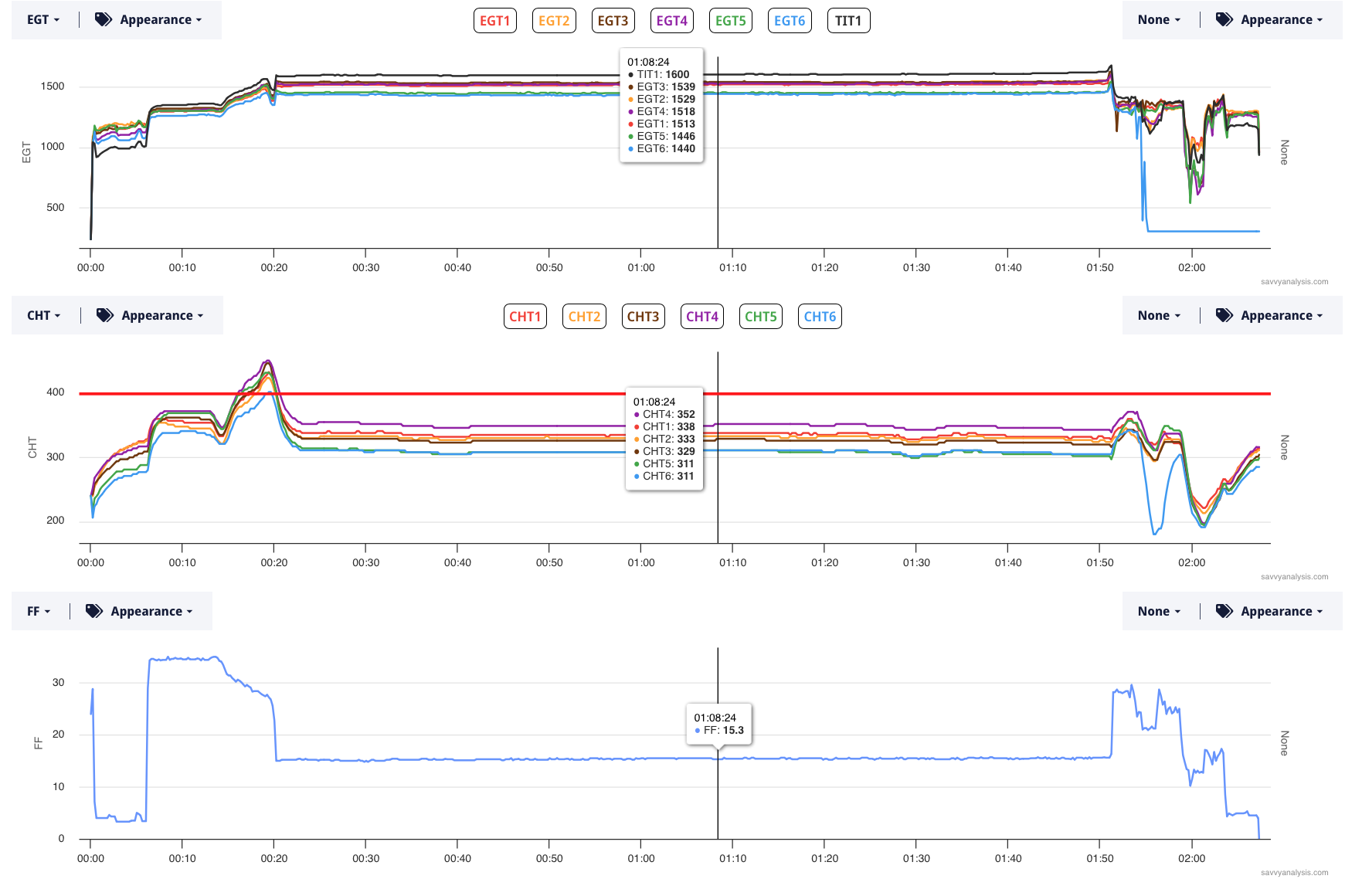It’s a logical question. You see something abnormal in the data and you wonder if your powerplant management triggered or provoked what happened. I’d say about a third of the tickets I work include some form of the question. Another popular question is “Should I have seen this coming?” and that’s more or less the mission of the monthly Puzzlers. When SavvyAnalysis Pro opened our doors 10 years ago we saw a lot of high CHTs in initial climb because pilots were leaning aggressively just after takeoff. Apparently they were anxious to set their cruise fuel flow for lean of peak – but doing it too soon. We don’t see that scenario as much these days.
Exhaust valve failure is another one where pilots wonder if powerplant management triggered or provoked what happened. The legacy mindset was that high EGTs were causing valves to burn – just keep fuel flow high to keep EGTs lower and you won’t have burned valves. If that were true then we should see a far greater number of burned valves in low compression/higher EGT engines like the Continental O-470-R than in a high compression/lower EGT engine like the IO-520-K. And we don’t. (Mike Busch’s May 2022 article for AOPA Pilot covered valve guides and rotocoils.) But there are things that pilots do that can provoke trouble from the engine.
Let’s start with data from a Socata Trinidad TB-20 powered by a Lycoming IO-540 engine and data from an Insight G4 with a 1 sec sample rate. EGTs on top, with CHTs and FF below. Here’s the entire 3:40 flight. Cursor is off to the left to get it out of the way.

The red trace of CHT 1 is jumpy throughout and is probably a loose connection. Let’s ignore that. There are two takeoffs in the timeline. The first takeoff at about 12 mins in the timeline looks normal. EGTs in the mid-1300s and CHTs in the mid-300s. Let’s divide the flight into two legs. Here’s the first leg ending just before the one hour mark.

The cursor is on the rise in CHT 5 which happens when FF is increased. The other CHTs drop as expected with a richer mixture. CHT 5 had already been on the high side beginning at engine start, and made a rise at the 30 min mark without a change in FF, and you can see the green line of EGT 5 drops there. Before we point fingers at the pilot, those are subtle changes that are hard enough to spot in quiet examination, much less with a handful of airplane to contend with. And you have to wonder if the pilot noticed anything at all with EGT or CHT 5 given the distraction of the CHT 1 data. Now let’s look at the second leg – zoomed into the detonation event at the one hour mark.

The cursor is on the initial FF setting of 18.7 GPH. Max FF on the first takeoff was 24.5 GPH. If you’re wondering if the lower FF was altitude compensation – no. The elevation of the 2nd departure airport is 470 msl. It could be that the pilot leaned a little for taxi, then forgot to go full rich for takeoff. Whatever the reason, cylinder 5 is clearly not happy with the reduced FF. EGT 5 starts out ok – it’s 3rd coolest at the cursor – then drops as the others stabilize. CHT 5 goes exponential and ends somewhere north of 600º. It’s up there for about 4 mins even after the pilot goes full rich. That’s 100º higher than Lycoming’s CHT redline – and about 200º higher than Savvy likes to see for cylinder longevity.
Notice that as CHT 5 climbs through 500º at 01:06, EGT 6 gets wobbly – corroborated by a drop in CHT 6. The question then becomes was there also a combustion issue with cyl 6, or is what we’re seeing in 6 connected (literally, via con rods) to the events in cyl 5? Data can’t answer that one – time for a borescope inspection.
To the question “Should I have seen this coming?” yes – but. There are those earlier rises in CHT 5 indicating something not quite right, but it would have been hard to spot that in real time. To the question “Is there something I could have done to prevent this?” the answer is pretty clearly an improper mixture setting.
Before we leave this data, consider what you would have done at the 01:12 mark after going full rich brought CHT 5 back below redline and EGT 5 was about as high as you’d expect with one plug not firing. Would you declare an emergency and return for landing? Would you climb in the vicinity of the airport for a while? Or would you continue on as planned and fly for another 2 hours as this pilot did?
Here’s data from a Beech Bonanza 36 with a Continental IO-550-TN (turbo-normalized) engine and data from a JPI 930 with a 1 sec sample rate. EGTs on top, then CHTs and FF. Here’s the whole flight with the cursor in the middle of cruise.

Let’s start with the blue traces near the end of the flight. EGT 6 wobble for a bit, then flatlines at 01:55. By itself, it looks like the connection was severed – except it flatlines at a non-zero number. When you add in the big drop and recovery in CHT 6, it’s acting more like unusual combustion than bad data. Borescope inspection is a good next step.
Takeoff is about the 7 min mark. EGTs, CHT, and FF all look good. At about 15 mins, the pilot starts leaning. GPS ALT is not logged, but OAT indicates he’s still climbing and cruise begins when he leans at the 20 min mark. So those last 5 mins of climb are with a steady decrease in FF – which CHTs don’t like at all. Highest temp reached is CHT 4 at 451º which is 1º over Continental’s redline.
My private pilot training was a long long time ago, but one thing my instructor said stuck with me, and I suspect many instructors have said it to many students. When something bad starts happening think back to the last thing you did. When the CHT’s started rising, why didn’t the pilot stop leaning more to the point, why was he leaning at all? It put him right in the red box that we try and stay out of.
And we have another case of a pilot correcting runaway CHTs then continuing on for an hour and a half – probably hoping that the excursion didn’t do anything harmful.